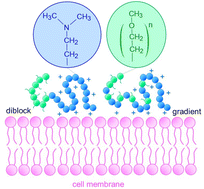How does the polymer architecture and position of cationic charges affect cell viability?†
Abstract
Polymer chemistry, composition and molar mass are factors that are known to affect cytotoxicity, however the influence of polymer architecture has not been investigated systematically. In this study the influence of the position of the cationic charges along the polymer chain on cytotoxicity was investigated while keeping constant the other polymer characteristics. Specifically, copolymers of various architectures, based on a cationic pH responsive monomer, 2-(dimethylamino)ethyl methacrylate (DMAEMA) and a non-ionic hydrophilic monomer, oligo(ethylene glycol)methyl ether methacrylate (OEGMA) were engineered and their toxicity towards a panel of cell lines investigated. Of the seven different polymer architectures examined, the block-like structures were less cytotoxic than statistical or gradient/tapered architectures. These findings will assist in developing future vectors for nucleic acid delivery.



 Please wait while we load your content...
Please wait while we load your content...